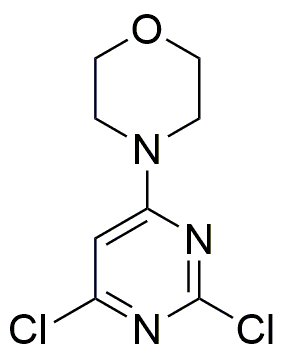4-(2,6-Dichloro-4-pyrimidyl)morpholine is widely utilized in research focused on:
- Pharmaceutical Development: This compound serves as a key intermediate in the synthesis of various pharmaceuticals, particularly in the development of antiviral and anticancer agents.
- Agricultural Chemicals: It is used in the formulation of crop protection products, helping to enhance the efficacy of pesticides and herbicides, thereby improving agricultural yields.
- Biochemical Research: Researchers leverage its properties to study enzyme inhibition and receptor binding, which can lead to breakthroughs in understanding disease mechanisms.
- Material Science: The compound is explored for its potential in creating advanced materials, including coatings and polymers, due to its unique chemical structure.
- Environmental Applications: It is investigated for its role in developing environmentally friendly solutions, such as biodegradable pesticides that minimize ecological impact.
Informations générales
Propriétés
Sécurité et réglementation
Applications
4-(2,6-Dichloro-4-pyrimidyl)morpholine is widely utilized in research focused on:
- Pharmaceutical Development: This compound serves as a key intermediate in the synthesis of various pharmaceuticals, particularly in the development of antiviral and anticancer agents.
- Agricultural Chemicals: It is used in the formulation of crop protection products, helping to enhance the efficacy of pesticides and herbicides, thereby improving agricultural yields.
- Biochemical Research: Researchers leverage its properties to study enzyme inhibition and receptor binding, which can lead to breakthroughs in understanding disease mechanisms.
- Material Science: The compound is explored for its potential in creating advanced materials, including coatings and polymers, due to its unique chemical structure.
- Environmental Applications: It is investigated for its role in developing environmentally friendly solutions, such as biodegradable pesticides that minimize ecological impact.
Documents
Fiches de données de sécurité (FDS)
La FDS fournit des informations de sécurité complètes sur la manipulation, le stockage et l’élimination du produit.
Spécifications du produit (PS)
Le PS fournit une description complète des propriétés du produit, notamment sa composition chimique, son état physique, sa pureté et les exigences de stockage. Il détaille également les plages de qualité acceptables et les applications prévues du produit.
Certificats d'analyse (COA)
Recherchez des certificats d'analyse (COA) en saisissant le numéro de lot du produit. Les numéros de lot et de lot se trouvent sur l'étiquette d'un produit, après les mots « Lot » ou « Lot de fabrication ».
Numéro de catalogue
Numéro de lot/série
Certificats d'origine (COO)
Ce certificat d'exploitation confirme le pays dans lequel le produit a été fabriqué, et détaille également les matériaux et composants utilisés et s'il est issu de sources naturelles, synthétiques ou autres sources spécifiques. Ce certificat peut être requis pour les douanes, le commerce et la conformité réglementaire.
Numéro de catalogue
Numéro de lot/série
Fiches de données de sécurité (FDS)
La FDS fournit des informations de sécurité complètes sur la manipulation, le stockage et l’élimination du produit.
DownloadSpécifications du produit (PS)
Le PS fournit une description complète des propriétés du produit, notamment sa composition chimique, son état physique, sa pureté et les exigences de stockage. Il détaille également les plages de qualité acceptables et les applications prévues du produit.
DownloadCertificats d'analyse (COA)
Recherchez des certificats d'analyse (COA) en saisissant le numéro de lot du produit. Les numéros de lot et de lot se trouvent sur l'étiquette d'un produit, après les mots « Lot » ou « Lot de fabrication ».
Numéro de catalogue
Numéro de lot/série
Certificats d'origine (COO)
Ce certificat d'exploitation confirme le pays dans lequel le produit a été fabriqué, et détaille également les matériaux et composants utilisés et s'il est issu de sources naturelles, synthétiques ou autres sources spécifiques. Ce certificat peut être requis pour les douanes, le commerce et la conformité réglementaire.


